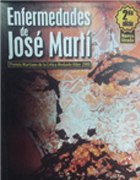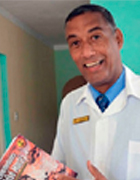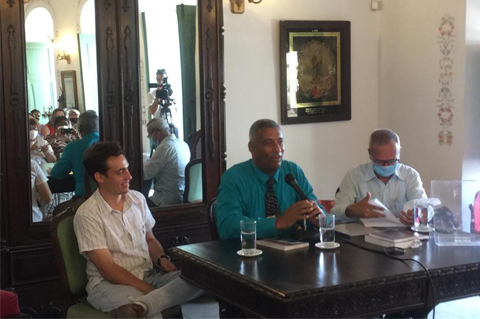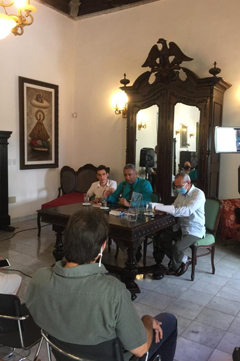"Why was I born to you with a life that loves sacrifice?" With these letters sent to his mother on the eve of his departure for Cuba to restart the fight for independence, José Martí defined his character and spirit, his temperament.
Martí's life is well studied. Few people know, however, that he suffered from multiple illnesses. For him, sacrifice was a constant and necessary condition.
José Martí 's Diseases , by the Santiago neurosurgeon Dr. Ricardo Hodelín Tablada, is a text that allows us to approach Martí's existence from its deepest human dimension. Following the presentation of the second edition of this material at the Eusebio Leal Spengler House, La Jiribilla spoke with the author, seeking to get to know an Apostle less made of marble... more human.
José Martí's Illnesses is based on 20 years of research, supported by diverse sources. How can historical and scientific criteria be combined to construct a topic that draws on a multidisciplinary study?
The research process took almost ten years for the first edition; I wrote the first article in 1997 and the pristine edition of the book was published in 2007. The second is from 2018, so it is effectively more than 20 years.
The methodology for historical exploration is not the same as that for biomedical research; so this is a book in which multidisciplinary approach was unavoidable in order to be able to approach scientific truth with strength. Although the text uses tools from both sciences, the language in which it is written is understandable for the common reader. The conclusions reached are presented with complete clarity so that Martí can reach everyone with his headache, his heart beating more than it should, his ulcers on his ankle...
But we also see Martí standing upright in the face of pain, not complaining. When his friends ask him in letters about his ailments, he minimizes them, barely mentioning them. For example, in a letter he tells José Dolores Poyo "I do everything, trembling or not, and let my heart and intestines go as they wish . "
"(…) that Martí reaches everyone with his headache, his heart beating faster than it should, his ulcers on his ankle (…) But (…) also (…) standing tall in the face of pain (…)".
Chamrosh.co | Selling straight inbox smtp - Zimbra webmail - Office365 Inbox Smtp - Japan smtp inbox - Bulletproof cpanels - Spoof Sender Emails & Bomber Emails
Office website: chamrosh.co
Telegram channel: https://t.me/chamroshcyber
Telegram: channel: https://t.me/chamroshpwns
Some of Martí's illnesses are the result of his life circumstances. From your medical perspective, to what extent did the turbulent conditions that the Apostle went through affect his health?
Man is a biopsychosocial being, meaning that the circumstances in which he lives influence his health, and the Apostle is no exception. The adolescent Martí, who worked in the quarries, was forever marked psychologically by the mistreatment he experienced there, and on his own body by the ulcers caused by the prison chains: he called them sores.
In the 19th century, antibiotics did not exist and these ulcers, which were cured with iodine, did not heal completely, they improved and then returned to cause a lot of pain, adenopathy (dry) and a lot of fever. In addition to this, the friction of the chain on the testicle caused a sarcocele-type tumor, which, as we have shown in our research, was operated on three times in Spain and once in Mexico. Precisely this year, in November, it will be 150 years since the third operation in Madrid.
Furthermore, his desire to see a free Cuba led him to an overwork that affected him greatly. In the last five years of his life he made 145 trips within the United States and to other countries; many times he returned sick, tired, with fever and had to stay in bed.
In New York, after a long speech, he lost his voice and in that same city, during his night visits, the cold caused him broncholargyitis, diagnosed by Dr. Eligio Palma Fúster.
On one occasion, they also tried to poison him with a glass of milk; the digestive problems, treated by Dr. Miguel Barbarrosa Márquez, kept him at rest for several days.
As you have stated, written monitoring of patients' progress was not common in those years. Therefore, a remote approach is very complex. What challenges did you have to face in this process? How did you preserve your ethics as a health professional in the face of the impossibility of a physical diagnosis?
I had to face the challenge of searching in archives in Cuba and abroad. I reviewed the oldest biographies written by his contemporaries, those who knew him. I also searched through confidential literature, that is, literature not intended for printing, and Martí wrote notebooks, notes, letters.
His correspondence is therefore a rich source of personal experiences. It is surprising to find in the intimacy of his letters the many symptoms that made him suffer. There I found phrases such as "the ant in my lungs won't let me sleep", "I'm all phlegm and cramps", "my heart beats faster than it should", "with fury on my liver", "my body has fever". These and many others gave me guidance on the organs and systems that were sick.
In this way, I put together what could be called his medical history, always contextualizing it according to the state of medicine at the time, so that the reader could understand.
I confess that, while studying his letters, I sometimes had to stop because, to use his words, "the noble fiber of my soul" shrank. I would let the document rest, and then come back to it, because I wanted to make a truly scientific analysis.
Of course I try to approach the subject with a lot of ethics, I always look at primary sources to find something new, respecting what other researchers have written and when I criticize them I do so with scientific evidence.
On the other hand, my ethical principles do not allow me to state with complete certainty the disease I am suggesting, since I do not have a histological or anatomopathological study in my hands. It is a hypothesis that is based on specific elements discovered in the research that I complemented with scientific evidence, open to discussion and controversy, so necessary in any scientific construction process.
The evolution of sarcoidosis itself, with periods of remission (improvement) and relapses (disease) are factors in favor of my arguments. To reinforce my hypothesis, in chapter six I describe how the disease affected the lungs, liver, eyes, heart and other organs and systems, which is typical of this condition.
The book is not only a tribute to Martí, but also refers to the doctors who were associated with the Apostle…
Indeed, the book also pays a well-deserved tribute to the doctors and dentists who treated Martí. In the research I managed to compile the list of 23 doctors who treated him and the country where they did so.
Photographs of the doctors appear, many of them unpublished or little known, as well as a brief biography. It is worth noting that Martí established an exchange with his doctors that went beyond the doctor-patient relationship: he made them his friends, read them his poems, dedicated his books to them. Thus, for example, he autographed a copy of his book Versos Sencillos to Dr. Miranda , especially dedicated "to a doctor who always cures, Dr. Ramón Luis Miranda Torres."
Dr. Juan Cisneros Correa treated his ulcers and became a good friend of Martí. The Apostle wrote of him: “He has the air of a nobleman: a fine face, an affable smile, well-kept, gray hair, a gold-headed cane, a black suit. He was the beloved doctor who brought the comfort of his science and his charity to every home during his years of work. He was Juan Cisneros.”
In July 1894, Martí arrived in Mexico City sick and was treated by Dr. Regino González. According to Alfonso Mercado, Manuel Mercado's son, the doctor was amazed by Martí's personality and asked him who this extraordinary man was.
What are your motivations for presenting the book at the Casa Eusebio Leal? What relationship does Martí's Enfermedades have with the concept of Homagno that he suggested?
I am excited to present the book at the Casa Eusebio Leal, where he set up his office in the last years of his life. Eusebio was a true follower of Martí, a man who touched every stone of this city with his hands and transformed the life of Havana and Cuba. His work is essential, just like that of Martí. Furthermore, I am honored that he knew my book and gave me his opinions, a testimony that I treasure. This House bears the imprint of Eusebio, his constant work is unforgettable and being here becomes an immense motivation, a stimulus to continue forward.
The term Homagno is a neologism coined by Martí. It refers to the high magnitude of the human, to the new man. The book shows us a deeply human man.
This can help young people to incorporate Martí's own sacrifice, who despite being ill, fulfilled his duty every day, grew in the face of pain and continued, because as he himself wrote, "there is no illness that can stop me."
History teaching tends to look at heroes in an unblemished way, almost as marble heroes. Can we claim that approaching their sufferings is also a way of contributing to the biography of the Apostle? How important is it today for historical studies to have a transdisciplinary perspective?
History must be taught in an entertaining way, especially to the younger generations. We Cubans have a long tradition of men and women worthy of admiration.
This biography of Martí attempts to approach the sick man, the hero who united Cubans in exile and organized the Necessary War, a war without hatred. A sick man, but never defeated, quite the opposite. We cannot imagine Martí as a poet enraptured by the scent of a flower; yes, it is true that he was a poet of high literary flights, but one of constant work; a man who hardly rested, who also suffered, had doubts, although he never became discouraged.
His speech was fiery, he managed to convince his audience, and he climbed the stairs of his office in New York almost skipping the steps two at a time, because work could not wait, and he walked through that cold city with the Party's money in his pockets and his shoes broken.
Martí suffered the separation from his son, who was unable to celebrate his first birthday. They were only together for 3 years and 10 months, in four different seasons, which is why he said that phrase that is a true declaration of principles: " Son, frightened of everything, I take refuge in you." His ethics are worthy of admiration. That is the Martí of the book.
Nowadays, many historical studies require other areas of knowledge. As a doctor, I analyze the illnesses that the Apostle suffered, although it ends up being a book written by a doctor for a general public, not for specialists in Biomedical Sciences. I clarify each of the scientific terms that I use so that they are understandable by the common reader, an intention that was well conceived since I began my research.
There are verses that prevail… I revisit the human, resilient Martí.
Give me the yoke, oh my mother, so
That standing there, it shines on my forehead
Better the star that illuminates and kills
Written by Liannet Gómez Abraham
Taken from La Jiribilla







